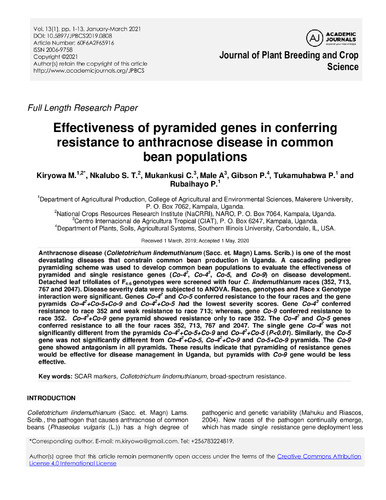Effectiveness of pyramided genes in conferring resistance to anthracnose disease in common bean populations
Anthracnose disease (Colletotrichum lindemuthianum (Sacc. et. Magn) Lams. Scrib.) is one of the most devastating diseases that constrain common bean production in Uganda. A cascading pedigree pyramiding scheme was used to develop common bean populations to evaluate the effectiveness of pyramided and single resistance genes (Co-42, Co-43, Co-5, and Co-9) on disease development. Detached leaf trifoliates of F4:6 genotypes were screened with four C. lindemuthianum races (352, 713,767 and 2047). Disease severity data were subjected to ANOVA. Races, genotypes and Race x Genotype interaction were significant. Genes Co-42 and Co-5 conferred resistance to the four races and the gene pyramids Co-42+Co-5+Co-9 and Co-42+Co-5 had the lowest severity scores. Gene Co-43 conferred resistance to race 352 and weak resistance to race 713; whereas gene Co-9 conferred resistance to race 352. Co-43+Co-9 gene pyramid showed resistance only to race 352. The Co-42 and Co-5 genes conferred resistance to all the four races 352, 713, 767 and 2047. The single gene Co-42 was not significantly different from the pyramids Co-42+Co-5+Co-9 and Co-42+Co-5 (P<0.01). Similarly, the Co-5gene was not significantly different from Co-42+Co-5, Co-42+Co-9 and Co-5+Co-9 pyramids. The Co-9gene showed antagonism in all pyramids. These results indicate that pyramiding of resistance genes would be effective for disease management in Uganda, but pyramids with Co-9 gene would be less effective.

